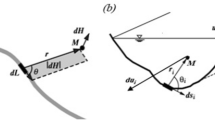Abstract
The diagnosis of current (diagnostic and adaptation calculations) with application of a complete non-linear model for the test area under study during Cruise 41 of R/VAkademik Vermadsky is reported. The model-based current velocities are compared with the observed ones. Hydrochemical and hydro-optical data were invoked to conduct an indirect analysis of the water circulation in the area under study.
Similar content being viewed by others
References
Sarkisyan, A. S.Numerical Analysis and Prediction of Marine Currents. Leningrad: Gidrometeoizdat (1977).
Sarkisyan, A. S., Demin, Yu. L., Brekhovskikh, A. L. and Shakhanova, T. V.Methods and Results of the Calculations of the Water Circulation in the World Ocean. Leningrad: Gidrometeoizdat (1986).
Marchuk, G. I. and Sarkisyan, A. S.Mathematical Modelling of the Ocean Circulation. Moscow: Nauka (1988).
Demin, Yu. L. and Ibraev, R. A. A numerical method for calculating currents and sea level in multiply connected areas of the ocean. Moscow (1988), (Preprint No. 183, USSR Academy Sciences, Dept. of Numer. Math.).
Demin, Yu. L. and Ibraev, R. A. A numerical method of the calculation of currents and sea surface topography in multiply connected domains of the ocean.Sov. J. Num. Anal. math. Modelling (1989)4 211–225.
Report on Cruise 41 of the R/V Akademik Vermadsky. Vol. 1, Part 2. Sevastopol: MHI, Ukr. SSR Academy of Sciences (1990), pp. 45–253.
Cochrane, J. D., Equatorial undercurrent and related currents of Brazil in March and April 1963.Science (1963)142, 669–681.
Metcalf, W. G. and Stalcup, M. C. Origin of the Atlantic equatorial undercurrent.J. Geophys. (1967)72, 4959–4975.
Knysh, V. V., Moiseenko, V. A. and Chernov, V. V. Some estimates of the vertical and statistical structure of temperature and salinity field disturbances in the North Atlantic tropical test area. In.Geophy. Research in Cruise 37 of R/V Akademic Vermadsky. Part 2. Hydrophysics of the Tropical Atlantic Dep. manuscript No. 3491-B90. Moscow: VINITY (1990), pp. 114–134.
Knysh, V. V., Moiseenko, V. A. and Chernov, V. V. Diagnosis of the large-scale circulation in the tropical test area on the basis of four-dimensional analysis. In:Investigations of the Tropical Atlantic. Sevastopol: MHI, Ukr. SSR Academy of Sciences (1989), pp. 166–177.
Additional information
Translated by V. Puchkin.
Rights and permissions
About this article
Cite this article
Demin, Y.L., Ibraev, R.A., Knysh, V.V. et al. Diagnosis of currents in the Brazil test area from temperature and salinity observations using a complete non-linear model. Soviet Journal of Physical Oceanography 3, 299–307 (1992). https://doi.org/10.1007/BF02197306
Issue Date:
DOI: https://doi.org/10.1007/BF02197306




